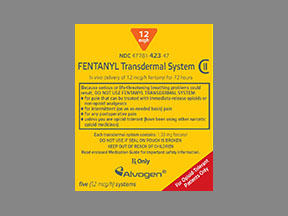My prescription
Edit
12MCG/HR, Fentanyl (10 Patch 72 Hours)
Select pharmacy

CVS
$38.93
COUPON PRICE
Walgreens
$54.44
COUPON PRICE
Albertsons
$105.25
COUPON PRICE
Walmart
$186.22
COUPON PRICEFentanyl savings card
Show this card to your pharmacist
CVS
$38.93
BIN
ID
PCN
GRP
019876
LH6D792B98
CHIPPO
LHX
Powered by
Related opioids prescriptions
More prescriptions for pain
Related opioids prescriptions
More prescriptions for pain
Fentanyl dosage forms
Dosage Quantity Price from Per unit 12MCG/HR 10 Patch 72 Hours $38.93 $3.89 12MCG/HR 1 Patch 72 Hour $17.74 $17.74 12MCG/HR 5 Patch 72 Hours $28.62 $5.72 25MCG/HR 1 Patch 72 Hour $13.94 $13.94 25MCG/HR 5 Patch 72 Hours $25.31 $5.06 25MCG/HR 10 Patch 72 Hours $32.32 $3.23 37.5MCG/HR 1 Patch 72 Hour $40.50 $40.50 37.5MCG/HR 5 Patch 72 Hours $129.29 $25.86 37.5MCG/HR 10 Patch 72 Hours $240.28 $24.03 50MCG/HR 1 Patch 72 Hour $16.90 $16.90
| Dosage | Quantity | Price from | Per unit |
|---|---|---|---|
| 12MCG/HR | 10 Patch 72 Hours | $38.93 | $3.89 |
| 12MCG/HR | 1 Patch 72 Hour | $17.74 | $17.74 |
| 12MCG/HR | 5 Patch 72 Hours | $28.62 | $5.72 |
| 25MCG/HR | 1 Patch 72 Hour | $13.94 | $13.94 |
| 25MCG/HR | 5 Patch 72 Hours | $25.31 | $5.06 |
| 25MCG/HR | 10 Patch 72 Hours | $32.32 | $3.23 |
| 37.5MCG/HR | 1 Patch 72 Hour | $40.50 | $40.50 |
| 37.5MCG/HR | 5 Patch 72 Hours | $129.29 | $25.86 |
| 37.5MCG/HR | 10 Patch 72 Hours | $240.28 | $24.03 |
| 50MCG/HR | 1 Patch 72 Hour | $16.90 | $16.90 |
| 50MCG/HR | 5 Patch 72 Hours | $32.56 | $6.51 |
| 50MCG/HR | 10 Patch 72 Hours | $46.82 | $4.68 |
| 62.5MCG/HR | 1 Patch 72 Hour | $50.52 | $50.52 |
| 62.5MCG/HR | 5 Patch 72 Hours | $179.38 | $35.88 |
| 62.5MCG/HR | 10 Patch 72 Hours | $340.46 | $34.05 |
| 75MCG/HR | 1 Patch 72 Hour | $21.39 | $21.39 |
| 75MCG/HR | 5 Patch 72 Hours | $39.14 | $7.83 |
| 75MCG/HR | 10 Patch 72 Hours | $59.98 | $6.00 |
| 87.5MCG/HR | 1 Patch 72 Hour | $60.03 | $60.03 |
| 87.5MCG/HR | 5 Patch 72 Hours | $226.93 | $45.39 |
| 100MCG/HR | 1 Patch 72 Hour | $23.88 | $23.88 |
| 100MCG/HR | 5 Patch 72 Hours | $46.21 | $9.24 |
| 100MCG/HR | 10 Patch 72 Hours | $74.12 | $7.41 |
Fentanyl Warnings
The following safety and warning information outlines important considerations and potential risks associated with the use of the fentanyl patch. It is essential to follow these guidelines closely and consult with your healthcare provider if you have any questions or concerns.
Risk of Misuse and Addiction: Fentanyl patches are controlled substances with potential for misuse and addiction, leading to severe consequences like dangerously slow breathing and overdose. Be cautious if you have a personal or family history of substance or alcohol abuse, mental health conditions, or if you do not store or dispose of the patch properly.
Respiratory Depression: The fentanyl patch can cause life-threatening respiratory depression. If you experience symptoms such as shortness of breath, slow or shallow breathing, extreme sleepiness, confusion, or bluish skin or lips, seek emergency medical help immediately. Risks are heightened at treatment initiation, dose changes, high doses, in children, seniors, those who are frail, opioid-naïve individuals, and people with breathing issues.
Opioid Overdose: Adhere strictly to the prescribed dosage to avoid a potentially fatal overdose. Symptoms include unresponsiveness, extremely slow breathing, a slow heartbeat, extreme sleepiness, and cold, clammy skin. Those with a history of opioid use disorder or previous overdose should exercise extra caution.
Accidental Exposure: Accidental contact, use, or ingestion of the patch can result in serious harm, including slowed breathing, overdose, and death. Ensure patches are kept out of reach of children, visitors, and pets.
Heat Exposure: Exposure to heat sources such as heating pads, electric blankets, or sunbathing, or having a high fever can increase the risk of overdose due to increased fentanyl release. Avoid external heat sources and rigorous exercise.
Cognitive Impairment and Drowsiness: Fentanyl may cause extreme sleepiness and impair your ability to concentrate. Avoid alcohol and other sedative medications. Assess how the patch affects you before engaging in activities that require alertness.
Physical Dependence and Withdrawal: Long-term use may lead to dependence, with withdrawal symptoms such as anxiety, restlessness, and chills if the medication is suddenly stopped. Consult your prescriber before making any changes to usage.
Pregnancy Risks: Prolonged use during pregnancy can result in neonatal opioid withdrawal syndrome in newborns. Discuss with your healthcare provider if you are pregnant or planning to become pregnant.
Drug Interactions: Fentanyl can interact with various medications, potentially leading to increased side effects or diminished efficacy. Inform your healthcare team of all medications you are taking.
Serotonin Syndrome: Concurrent use with medications that increase serotonin can cause a life-threatening condition. Symptoms include nausea, vomiting, fever, and rapid heart rate. Seek immediate medical attention if symptoms occur.
Low Blood Pressure and Heart Rate: The patch can cause low blood pressure and slow heart rate, leading to dizziness or fainting. Be cautious when changing positions and inform your healthcare provider of any heart issues.
Low Adrenal Hormone Levels: Prolonged opioid use may lower adrenal hormone levels. Report symptoms like tiredness and nausea to your prescriber.
Seizures: There is an increased risk of seizures, particularly if you have a history of them. Seek medical assistance if you experience a seizure while on this medication.
Contraindications: Do not use the fentanyl patch if you are not opioid tolerant, have short-term pain, post-surgical pain, mild pain, respiratory depression, severe asthma, or conditions causing stomach blockages. Consult your healthcare provider if any apply.
This information is crucial for safe use of the fentanyl patch. Always follow your prescriber’s instructions and engage with your healthcare team for any concerns.
Fentanyl Side Effects
Common side effects:
- Nausea
- Vomiting
- Sleepiness
- Dizziness
- Trouble sleeping
- Constipation
- Excessive sweating
- Tiredness
- Feeling cold
Less common but important to monitor:
- Headache
- Diarrhea
- Stomach pain
- Dry mouth
- Fast heartbeat
- Sensations of feeling unwell
- Weakness
- Muscle spasms
- Numbness, burning, or tingling in the arms or legs
- Itching
- Rash
- Anxiety
- Confusion
Serious side effects:
- Dangerously slow breathing
- Bluish lips, fingers, or toes
- Extreme sleepiness
- Slow heartbeat
- Cold, clammy skin
- Anxiety
- Suicidal thoughts
- Irritability
- Hives
- Shortness of breath
- Swelling of the face or throat
Fentanyl Interactions
Fentanyl is a potent opioid medication used to manage severe pain. However, it can interact with various substances, leading to serious health risks. Understanding these interactions is crucial for safe use.
Central Nervous System (CNS) Depressants: Combining fentanyl with other CNS depressants—such as alcohol, benzodiazepines (like Diazepam or Alprazolam), sedatives, or other opioids—can result in profound sedation, respiratory depression, coma, or even death. It's essential to avoid using these substances together unless under strict medical supervision.
CYP3A4 Inhibitors and Inducers: Fentanyl is metabolized in the liver by an enzyme called CYP3A4. Certain medications can affect this enzyme's activity:
Inhibitors (e.g., Ketoconazole, Erythromycin, Ritonavir): These can slow down fentanyl metabolism, leading to increased drug levels in the body and a higher risk of adverse effects. Close monitoring and possible dose adjustments are necessary when these are used concurrently.
Inducers (e.g., Rifampin, Carbamazepine, Phenytoin): These can speed up fentanyl metabolism, reducing its effectiveness. Patients may require higher doses of fentanyl, but this should only be done under medical guidance.
Serotonergic Drugs: Using fentanyl alongside medications that increase serotonin levels—such as certain antidepressants (SSRIs, SNRIs, MAOIs), triptans, or Linezolid—can lead to serotonin syndrome. This potentially life-threatening condition is characterized by symptoms like agitation, hallucinations, rapid heartbeat, high blood pressure, fever, nausea, vomiting, diarrhea, muscle rigidity, dizziness, tremor, and seizures. Immediate medical attention is required if these symptoms occur.
Monoamine Oxidase Inhibitors (MAOIs): Fentanyl should not be used with MAOIs or within 14 days of stopping such treatment. This combination can lead to severe and unpredictable reactions, including respiratory depression and coma.
Anticholinergic Drugs: Concurrent use of fentanyl with anticholinergic medications can increase the risk of urinary retention and severe constipation, potentially leading to a serious condition called paralytic ileus, where the intestines stop moving properly.
Diuretics: Fentanyl may reduce the effectiveness of diuretics by promoting the release of antidiuretic hormone, which can lead to fluid retention and decreased diuretic efficacy.
Grapefruit Juice: Consuming grapefruit or grapefruit juice can inhibit CYP3A4, leading to increased fentanyl levels in the blood and a higher risk of adverse effects. It's advisable to avoid grapefruit products while using fentanyl.
Alcohol: Combining alcohol with fentanyl can enhance sedative effects, leading to dangerous side effects such as respiratory depression, profound sedation, coma, and death. It's crucial to avoid alcohol consumption during fentanyl treatment.
Always inform your healthcare provider about all medications, supplements, and substances you are using to prevent harmful interactions. Never adjust your fentanyl dosage or combine it with other substances without professional medical advice.

